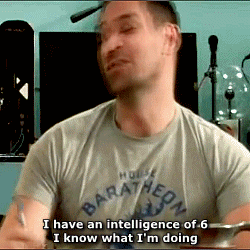GM Tips, hosted by the talented veteran Game Master Satine Phoenix, is our show to help Dungeon Masters and Game Masters improve their craft and create memorable roleplaying experiences. Last week, we tore up sheets and covered playing dirty, but this week we talk about how limitations in your game focus your story.
The elevator pitch, the cliff notes, the treatments and more—limitations are used in every aspect of creative entertainment to polish work. Why should the act of running games and storytelling be any different? Writers use enforced word counts and show writers have to deal with episode timers, it can often be seen as a hindrance but it’s anything but. Two sentence horror stories are a prime example of limitations enhancing your story: “I can’t move, breathe, speak, or hear and it’s so dark all the time. If I knew it would be this lonely, I would have been cremated instead.”
In this episode on GM Tips with Satine Phoenix, Sax Carr returns to cover this very concept. Get caught up below!
Tactical Waifu sounds like one of the best one page RPG’s ever. Frankly, I don’t know why this isn’t in my life right now. Particularly since it’s free. Alright, one-page RPG’s and reasons to limit your story abound, here are some practical tips to merge this advice with your existing campaigns or develop new spin-offs.
Setting the Sandbox
If you find yourself, having a case of the writer’s block regarding your next adventure, rather than research fifty books looking for the big campaign idea; reverse the thought. Try planning an entire adventure inside an entire city or even a single school. Hogwarts is pretty damn popular I hear. A case can be made to debate the sandbox nature of RPG games, particularly tabletop ones, but in this specific case—we are referring only to limitations regarding the setting.
Rather than create the entire continent of Faerun, narrow down your entire campaign to a single town or village. This will allow all of that creative energy to flow into NPC’s and detailed landscapes. Rather than craft nations from a high level, you’ll be defining how Rocket Noodles taste or how much debt a local gambler is in. It is also vastly less daunting and a great tip for GM’s getting off the ground. When the players are finally done with the town, you can easily build out from there.
Restricting Player Choice
By the same metric that having a narrowly defined setting can sharpen the GM’s pencil, limiting the players can do the same for them. Even if players initially bristle at the idea of restricted material. This is particularly useful when creating the game from the ground up (or spinning off an existing campaign). It’s common to hear storytellers restrict which books they feel are cannon, often citing reasons for things being broken, or not being comfortable with the material presented in later expansions. These are valid reasons, but these same limitations can be spun into positives within the story framework.
For example; limiting your entire party of players to only play wizards, but also allowing any book or wizard supplemental material is a great way to narrow the campaign focus for you and the players. When you set limitations that are both narrow in scope with plenty of source material the campaigns and character concepts start to write themselves. We mentioned previously how Satine has created a campaign along these lines – Sirens of the Realms – where the players were multiclass bards.
People get excited just thinking of the idea, for good reason. Imagine it: a troupe of all barbarians going ham in a stealth campaign? Sounds fun!
Introduce Bad Equipment

Ever play in a fantasy campaign with… no magical gear? Or how about a Cyberpunk campaign where planned obsolescence was baked into your kidney by the mega-corps? If you haven’t, this is one tip you can drop into your existing campaign, right now, regardless of what you already have going on. Cursed equipment, machine guns that jam at the wrong time, or a dying friend’s wish that you use his sword to slay the Mindflayer are things that can be done mid-chronicle to great effect.
A piece of gear is nothing more than a tool for the character to impact the world with. By turning the equipment into an obstacle, it’s a limitation that must be overcome by the character—to the benefit of the game. Think about it this way in these two scenarios: One scenario I give your level 3 fighter a +5 Holy Avenger of Awesome, and in the other scenario you get a wooden practice sword your father trained you with. Then you are sent after a vampire. In the game, you most likely approach both scenarios differently even though the encounter (the vampire) is the same. The small limitation of what gear you have can have a drastic impact on the story that unfolds.
If you’ve played in a game where the GM put some limitations on everyone tell us! Leave a comment below and share your story with us!
Looking for More Useful GM Tips?
- How to handle Story Derailment
- Get your kids into Roleplaying Games!
- Shop the Geek & Sundry store for odd things like this Critical Role Throwback Poster!
Featured Image: Stone Tablet 05 – The Ogre and the Flower by Wei Wei Nan. Featured on Geekscapes.com
Rick Heinz is the author of The Seventh Age: Dawn, and a storyteller with a focus on LARPs, Wraith: The Oblivion, Eclipse Phase, and many more. You can follow game or urban fantasy related thingies on Twitter or Facebook.

